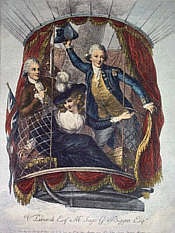Aviation Art
The emergence of Aviation ArtAviation art has emerged from the interest of visual artists in aviation themes. It has actually been around since the earliest days of aviation. As early as from the first manned ascent of a hot air balloon in 1783 when Pilâtre de Rozier and the Marquis d'Arlandes with their Montgolfiere 'drove' over Paris, there were many paintings and art prints, which at that time was not yet refered as aviation art though.
 In the pioneering days of aviation, aircraft and their pilots was a topic gladly taken up by the press. Aviation pioneers such as the Wright Brothers and Charles Lindbergh were the 'Heroes of the Air'. Periodically there were new records and sensational performances to report about and many of these events were captured in pictures by draftsmen and painters.
In the pioneering days of aviation, aircraft and their pilots was a topic gladly taken up by the press. Aviation pioneers such as the Wright Brothers and Charles Lindbergh were the 'Heroes of the Air'. Periodically there were new records and sensational performances to report about and many of these events were captured in pictures by draftsmen and painters.The aircraft manufacturers at that time needed talented graphic artists for illustrating flight manuals as well as technical instructions and in the advertising industry, artists with the capability to promote the benefits of a new aircraft or a new air service beneficially, were in great demand. In some countries, the Air Force also employed graphic designers and artists for illustrating manuals. In the U.S. Air Force, for a long time there was a unit for the training of aviation graphic artists and both the American and British Air Forces were and still are inviting artists to give them the opportunity to portray the Air Force missions.
A good example is the artistic career of Frank Wootton *1911-†1998, an artist well-known for his aviation paintings. After completion of training at the renowned Eastbourne College of Art in 1932 at the age of 18, he started his career as a freelance painter and illustrator. His drawing and painting skills as well as his style soon earned him commissions from automotive and aerospace manufacturers who recognized that the work of Frank Wootton enhanced their pictorial advertising.
To be continued soon ...
To be continued soon ...



